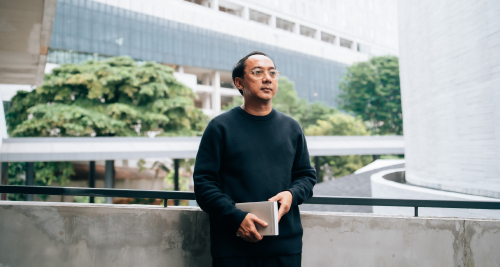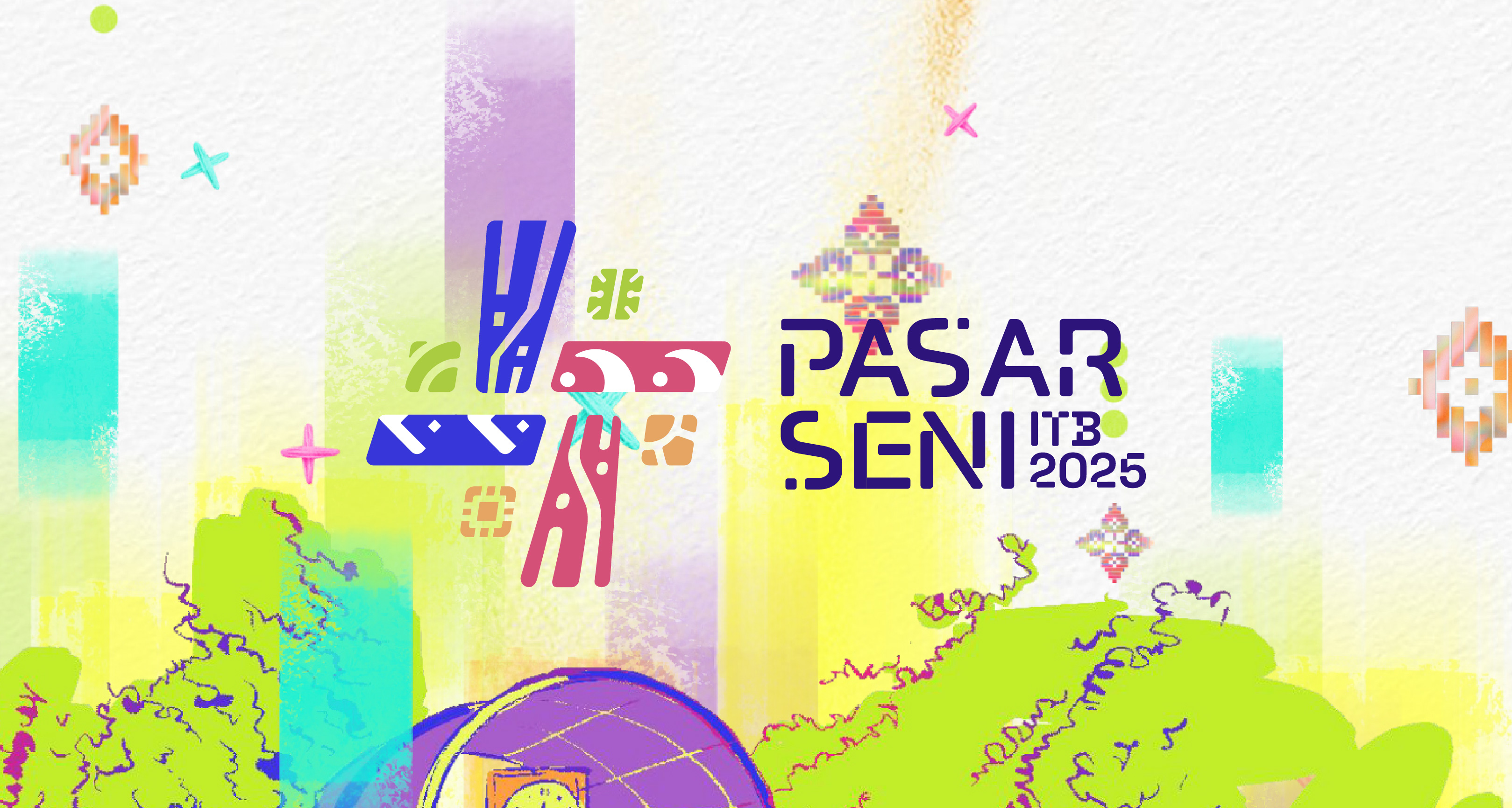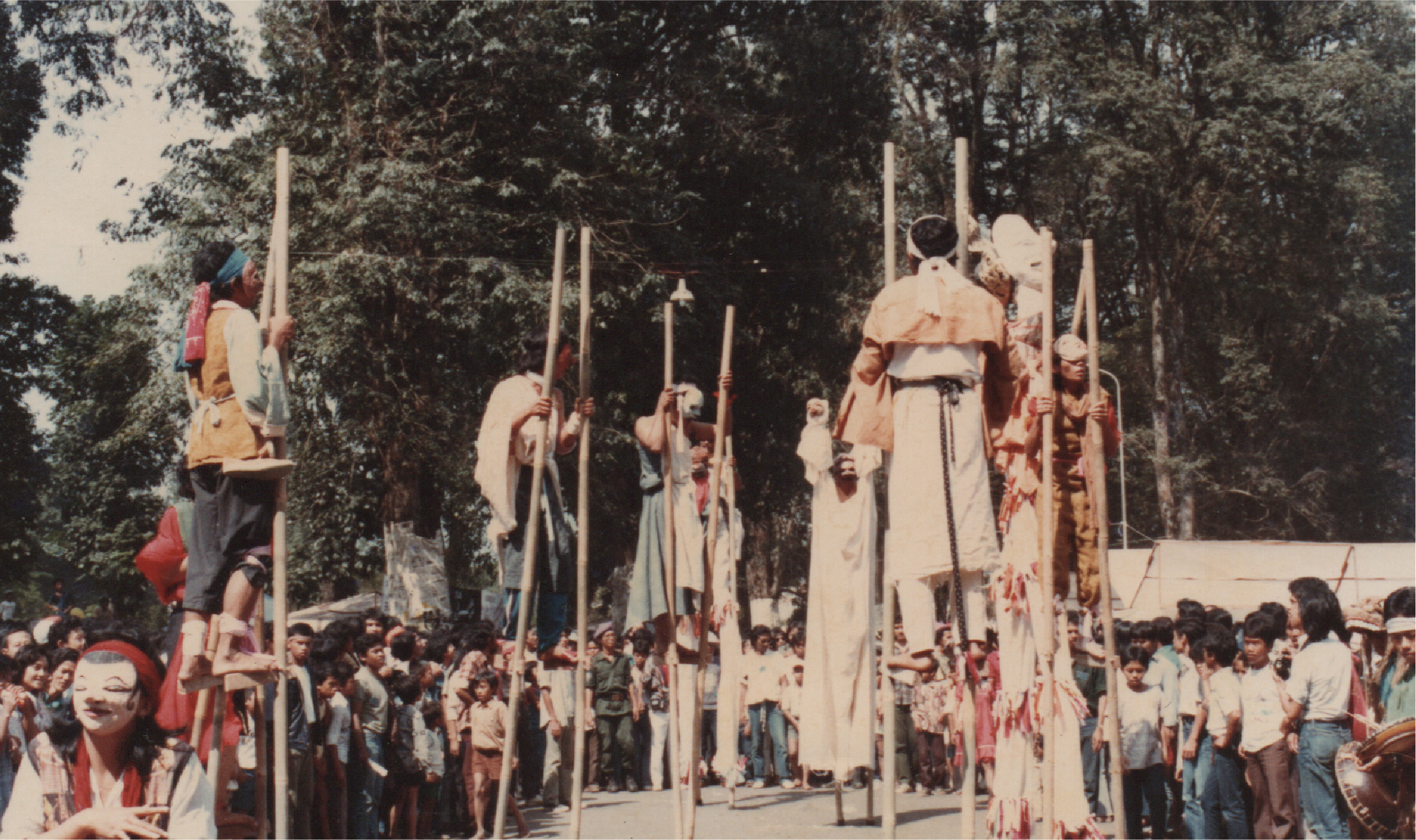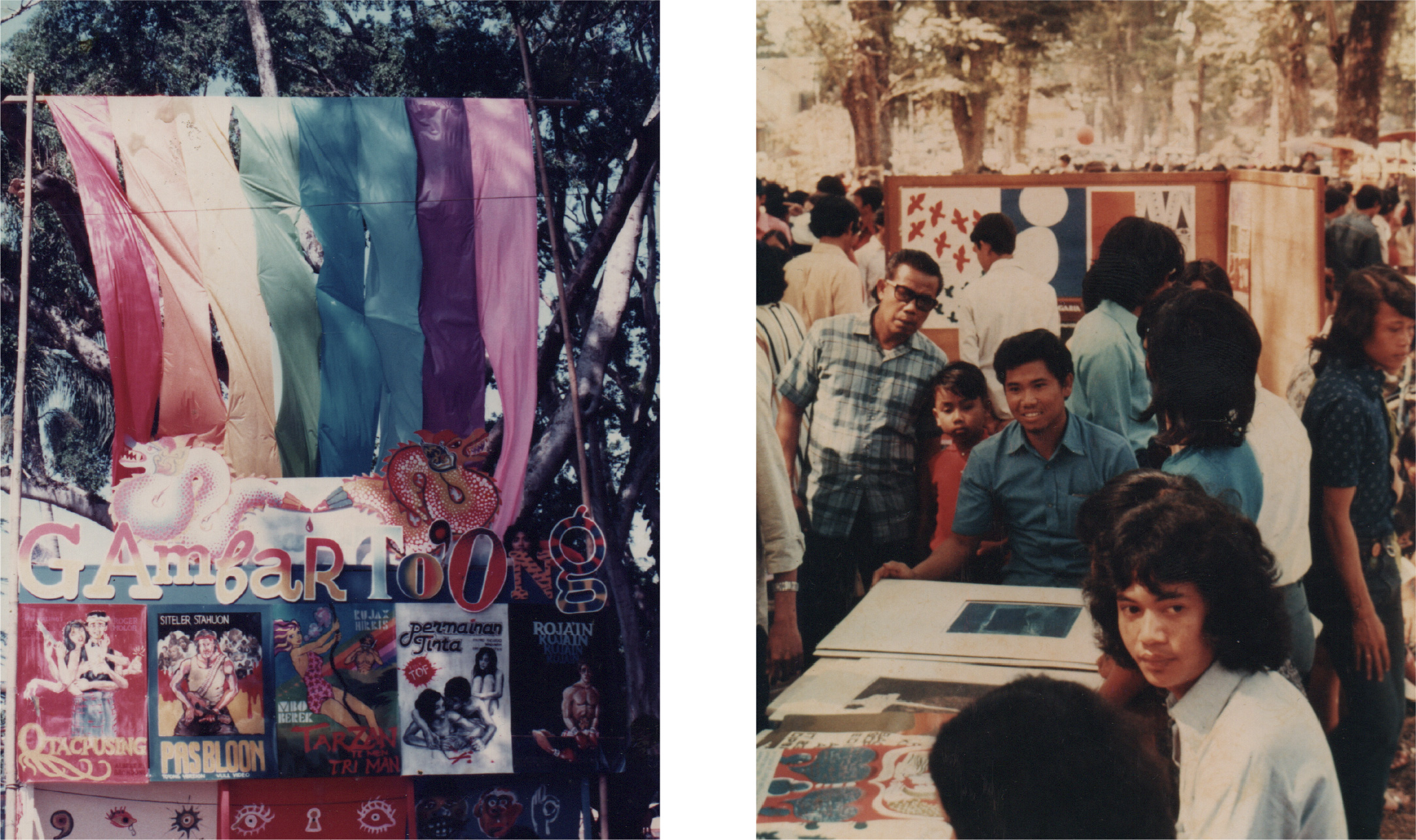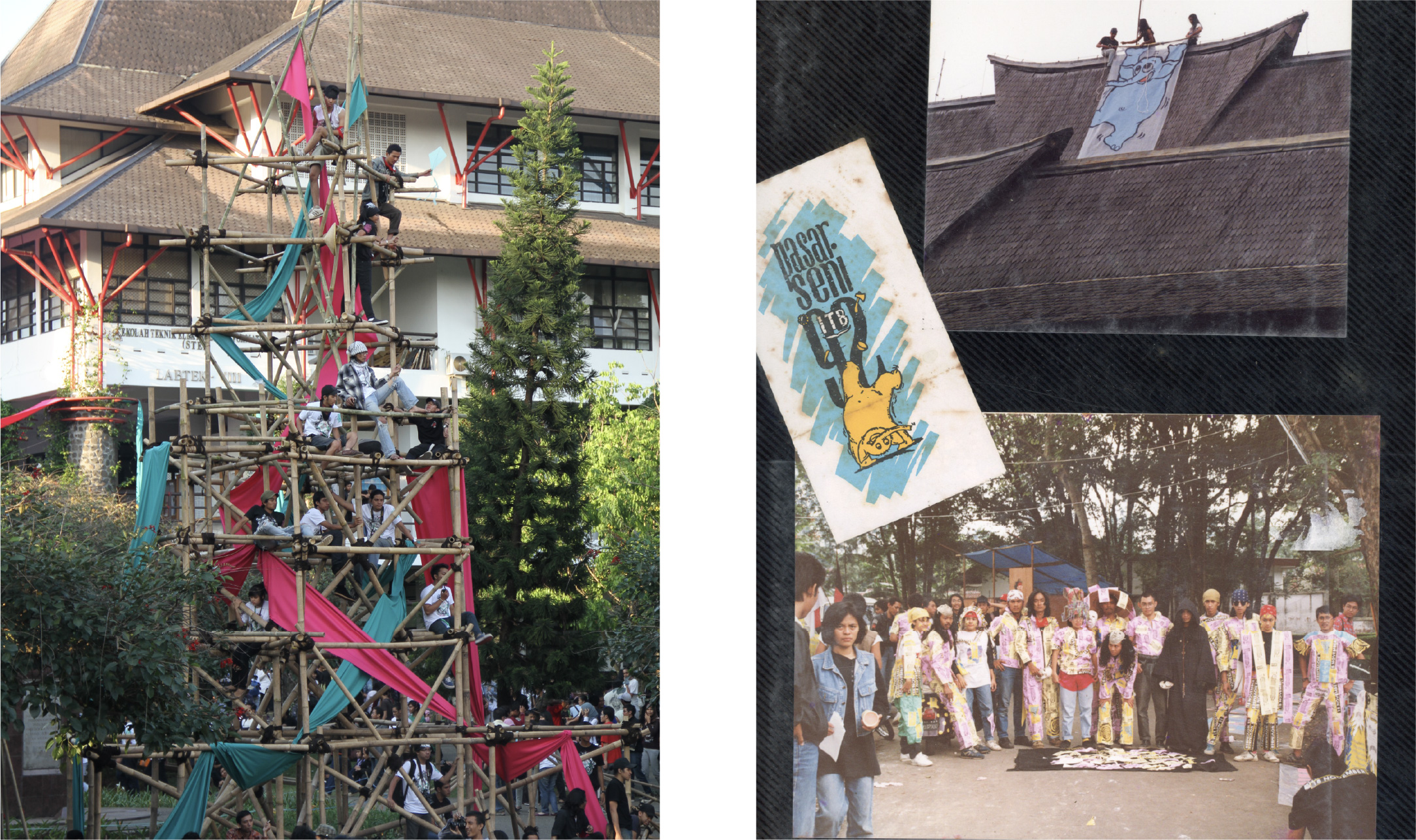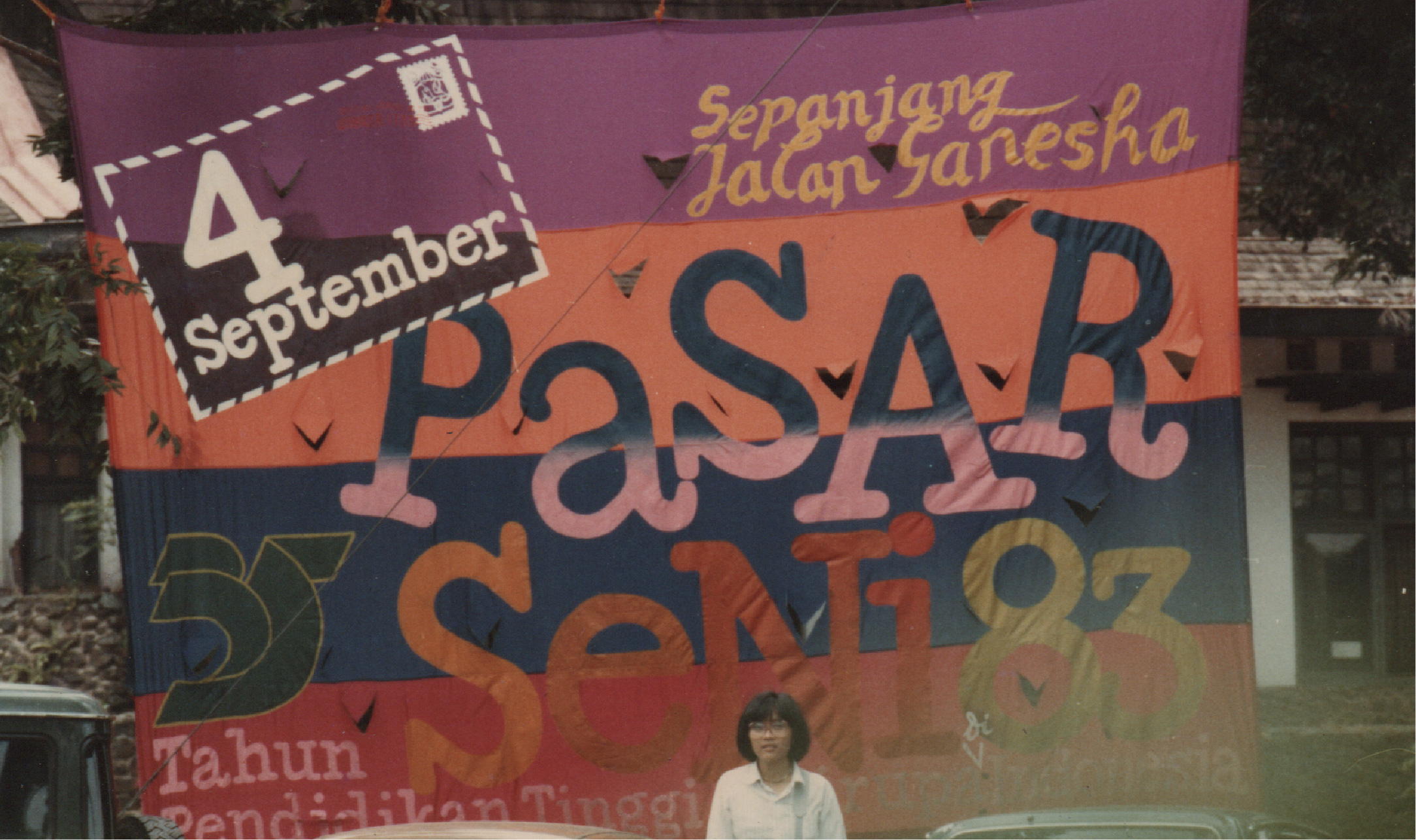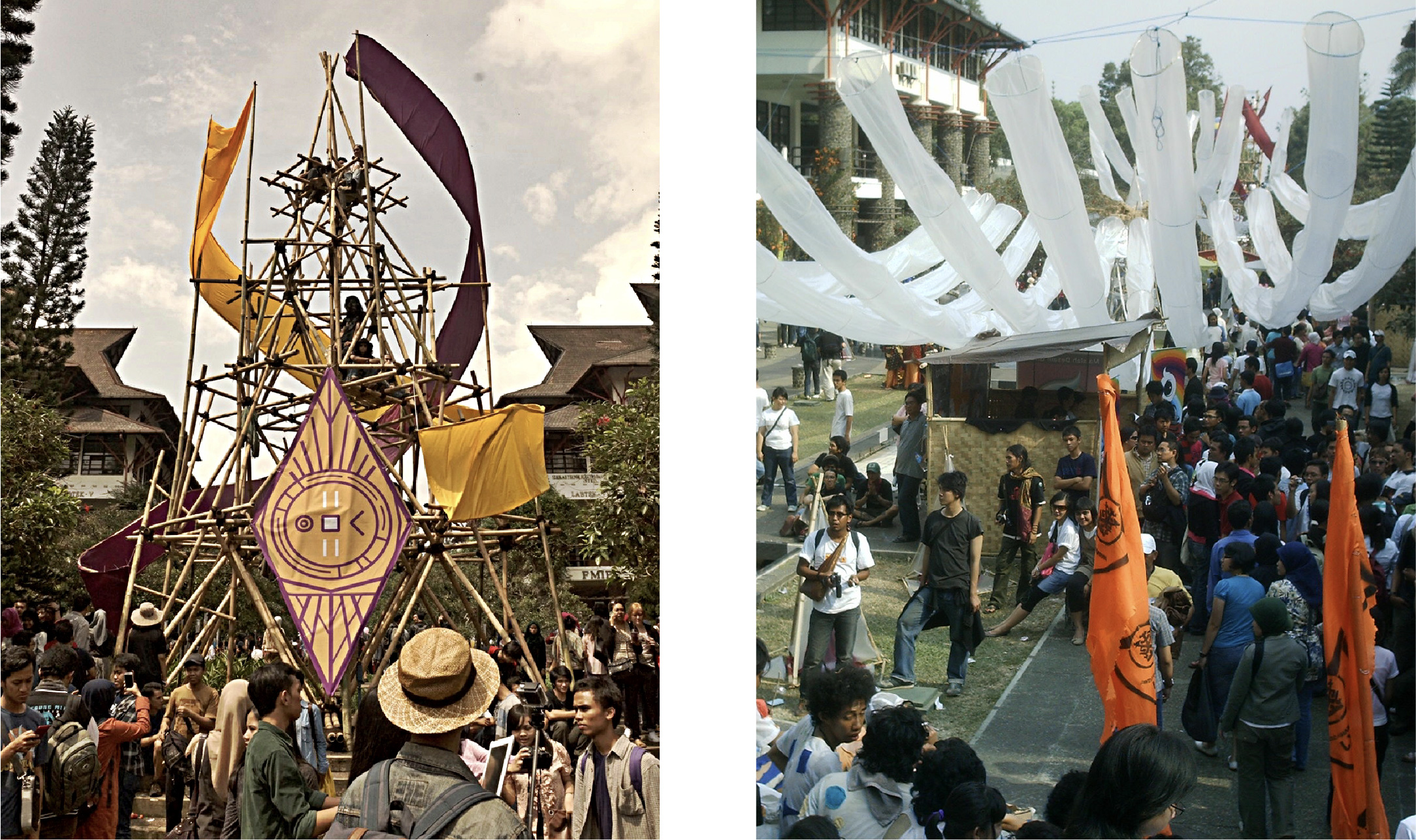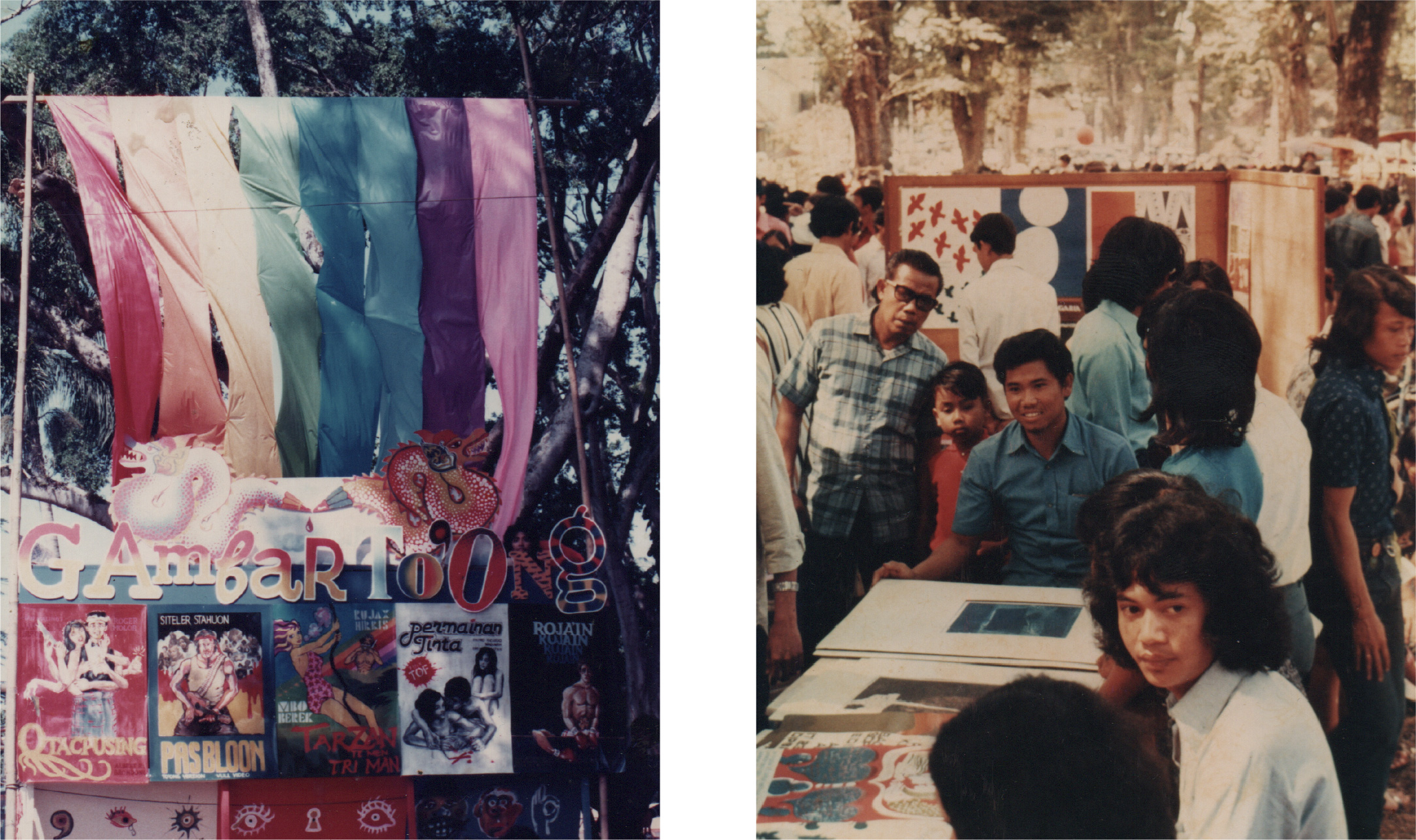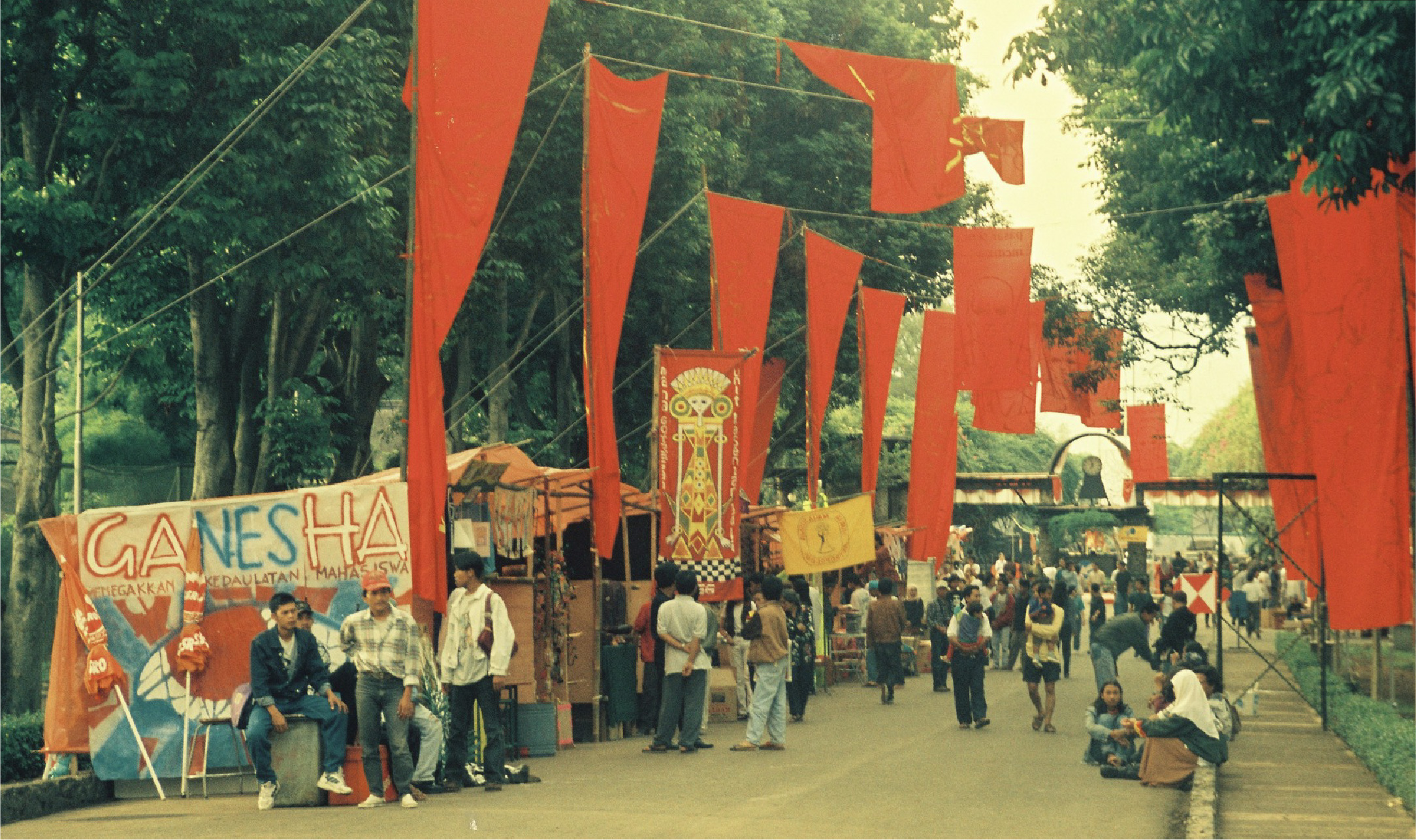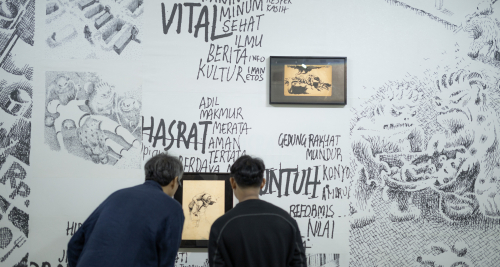Pasar Seni ITB 2025: Celebrating Hybrid Realities in “Setakat Lekat”
After eleven years of hiatus, one of the largest visual art and design festivals in Southeast Asia Pasar Seni ITB will be making its return. Since it was first held in 1972, Pasar Seni continuously served as an important and inclusive meeting space between artists and the public, marked by its public enthusiasm in the number of visits at 500,000 and 700,000 in its previous iterations.
Its upcoming edition is signified as a moment of renewal, with the committee’s ambitious target of bringing in 600,000 visitors (preferably from diverse backgrounds). In the midst of transition and turbulence, Pasar Seni is expected to remain a collective cultural space that offers inclusive, innovative, and widely impactful experience through its series of pre-events and main programs. From here, Pasar Seni does not solely function as an art exhibit, its space is intended for cross-community collaboration and intergenerational interaction.
Pasar Seni ITB originated from the idea of Prof. A.D. Pirous, a lecturer at the Faculty of Fine Arts at ITB, in 1972. The inspiration came after he visited the United States, where he encountered a garage sale and saw artists selling their works to the public at specific periods of the year. The practice not only invites economic transactions, but also retains artists’ productivity to create whilst also bringing new life to their previous work by preventing its deterioration in storage.
After this encounter, Pirous brought the format of the garage sale back to Bandung and proposed the creation of an event that would bring artists and the public together in an open space. The idea was soon enlivened by the participation of students and the academic community of Fine Arts at ITB, and brought upon the establishment of Pasar Seni – as an inclusive event designed for the artistic community and public to interact, without the worries of social boundaries.
The journey of Pasar Seni then marked the beginning of history, with each decade bringing forth new themes and issues into focus. The first two editions, in 1972 and 1976, concerned making art more accessible to the public, as visual art was considered exclusive and limited to certain circles. The running of Pasar Seni served as a defiance of this existing boundary and pushed for an inclusive experience for art to be enjoyed by the public through its presentation in open spaces, direct bidding and selling of these works; positioning art as a commodity available for all. This inclusive spirit has remained a foundation to this day.
In 1980, 1984, and 1988, Pasar Seni entered a new era that responded to Indonesia’s intensive development, and the rising influence of globalization. Through visual art, the event critiqued and responded to the issue of competition in the creative industry, and raised awareness of the current issue pressed amongst artists: how to preserve originality amid growing demands from the market and industry.
In its 1990 and 1995 iterations, Pasar Seni became more vocal about the importance of the freedom of expression in alignment with the repressive political landscape that was marked by restrictions. The public saw art as an important channel for expressing pent-up aspirations against the state, and turned to Pasar Seni as a cultural vessel and an important space to represent society’s longing to express themselves.
In 2000 and 2006, Pasar Seni confronted the challenges of the early digital era where information technology developed rapidly, and the flow of data intensified. Pasar Seni raised the theme of identity within the global stream, raising a question: how could Indonesian visual art maintain its local identity when the digital world relies on the never-ending delivery of information?
The last editions before their hiatus – throughout 2010 and 2014– highlighted awareness of scholarly and individual identity, establishing Pasar Seni as a space to reflect on the roles of art across both academic and personal dimensions. The 2014 theme, “Between Me, Us, and the Universe,” responded to the challenges of globalization and technology that increasingly influenced the relationship between individuals, communities, and their surroundings.
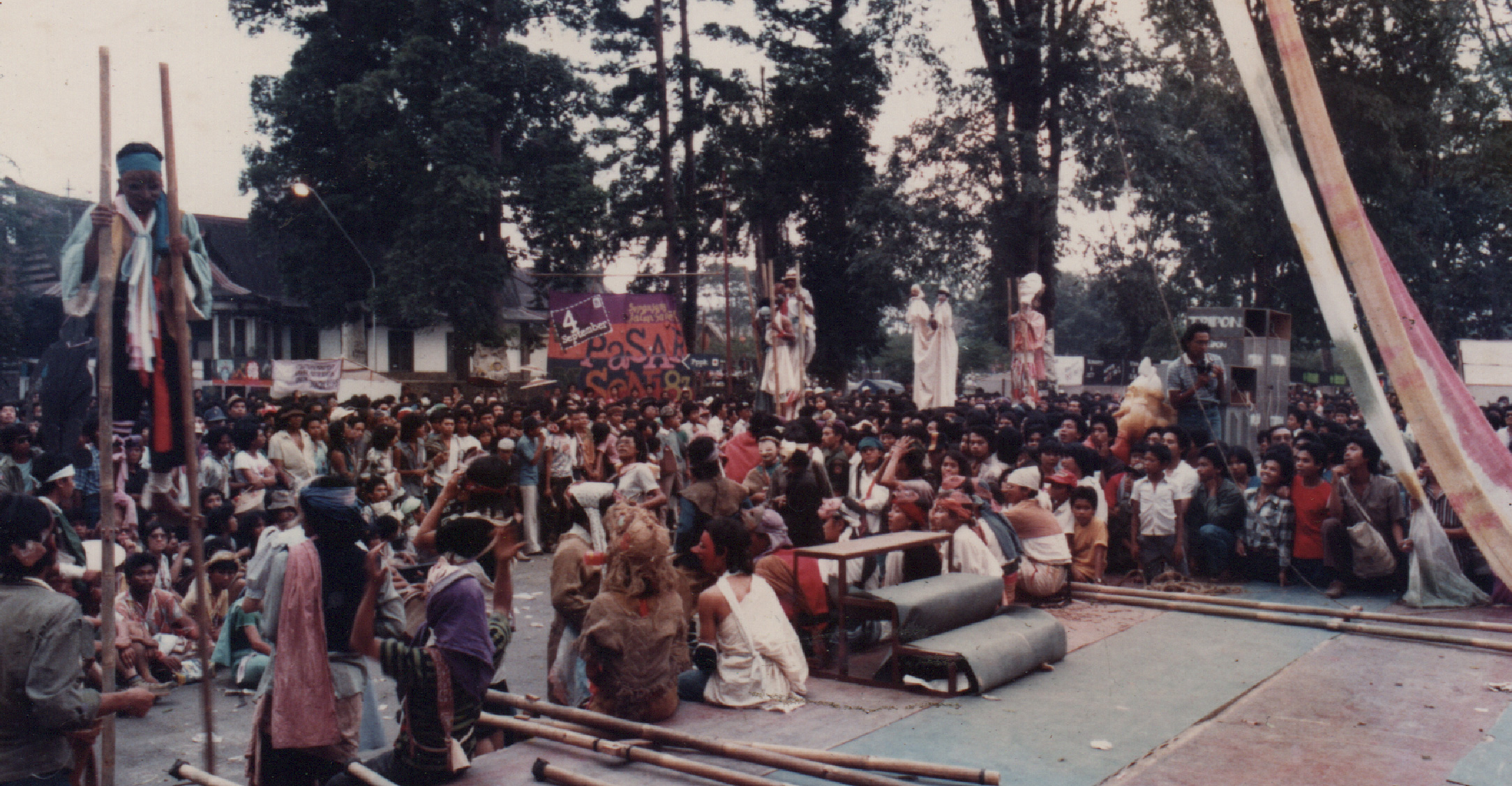
After 2014, Pasar Seni was absent for eleven years. The year 2025 marked a pivotal moment of its revival, as its preparations are currently undergoing with the involvement of multiple parties. ITB initially confirmed their institutional support, which will be further supplemented by the Bandung City Government through their provision of public space facilitation, interdepartmental coordination, and event management. Acting Governor of West Java, Bey Machmudin, stated that Pasar Seni is no longer only owned by the campus or the city of Bandung, but has become a national cultural stage. “Bandung is a place of artistic talent, but we feel that there was no event that had a national scale. Then, we remembered Pasar Seni and although it belonged to ITB, we wanted to claim it as collectively shared amongst Bandung, so much that it has become an icon of West Java. Thankfully, the event will be held again in 2025,” he said. With the establishment of Pasar Seni 2025, the event is expected to be a space of creative expression amongst students and young artists, as well as a cultural agenda long awaited by the public.
The main theme of this year’s iteration is “Setakat Lekat.”,made up of two words “setakat” translated to a certain point, while “lekat” means closely attached. It refers to the contemporary condition in which the virtual and the real are increasingly enmeshed throughout our daily life. This iteration also has an accompanying catchphrase as “Laku, Temu, Laju”, which comprises: Laku refers to human responses to the acceleration of information, Temu emphasizes the unification of virtual and real interactions, while Laju points to the inevitable pace of this new reality.
This philosophy is expanded into the Pasar Seni 2025 logo, where its hashtag symbol (#) was chosen for its close association with algorithms and the spread of information online. The symbol functions as a filter that allows access to curated content, which is a deeper reflection on how individuals select the information they consume and how their perceptions are formed. Other elements in the logo include: weaving as a metaphor for the relationship between humans and algorithms, veins as carriers of information, the brain as the processing center, the eye as the mediator between virtual and real, and signals as transmitters. All in all, the logo portrays the interconnectedness of humans with its hybrid realities between the virtual and the real.
The overarching visual identity of Pasar Seni ITB 2025 was developed as an enlivening of the overarching theme of “Setakat Lekat,” the intersection of virtual and real worlds that form a new reality. The graphic design team responded through explorations of form, texture, and technique as metaphors for the diversity of perception and information in the present era. In addition to the logo, this concept is reflected in color choices, composition, visual assets, and custom-designed typography. For the text, the design team created a typeface that combines dynamic and geometric forms, symbolizing the merging of two realities that the theme represents.
Pasar Seni ITB 2025 is built upon six key concepts. Sustainability emphasizes awareness of environmental, social, and economic dimensions in artistic practice. Reflective encourages critical discourse in response to the acceleration of information. Locality seeks to maintain the continuity of Indonesian culture in a global context. Community provides collective experiences and brings together groups that would otherwise remain separate. Contemporary highlights spontaneous creativity that requires direct involvement from visitors. Interdisciplinary promotes encounters across different fields of knowledge and artistic practices. These principles position Pasar Seni as a creative public space that actively involves the community in the artistic process.
To revive collective memory, the committee has organized several pre-events. The exhibition “Kilas Balik: Five Decades of Pasar Seni ITB” at Soemardja Gallery showcased visual documentation and artifacts from 1972 to 2014, reminding audiences of the festival’s long history and contribution to Indonesian art.
Other pre-events include “Sinestesia: Merayakan Kembali” at ITB’s Lapangan Merah, which offered multisensory experiences. There are also “Beranda Bersama,” “Sepanjang Masa,” “Saling Senggol,” and “Tapak Meriah,” designed to expand cross-community interactions.
At the peak of the event, the main programs will be presented in varied formats. “Pasa, Semangat Rupa” showcases visual artworks by diverse artists. “Laka Laku, Nyemal Nyemil” combines art with culinary experiences. “Saling Sua” creates direct interactions between communities and audiences. All programs emphasize active participation, intergenerational connections, and collective experience.
Pasar Seni ITB 2025 is not simply the return of a festival. It is a moment of revival that reaffirms the role of art in public life. Since its inception, Pasar Seni has grown alongside the changing times, recording social, political, and cultural dynamics.
With the theme “Setakat Lekat,” this year’s Pasar Seni seeks to interpret the new reality emerging from the meeting of virtual and real worlds. Through its programs, it opens broad participation, creates multisensory experiences, and strengthens connections between communities.
On October 19, 2025, when the main celebration takes place, Pasar Seni will once again become a grand gathering of art, design, and the public. A space to see, to feel, and to engage. More than that, Pasar Seni is a collective cultural event that reconnects memory and celebrates the times.






